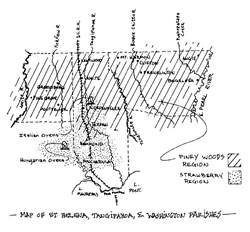Table of Contents
Folk Regions
Three Ethnic Perspectives
Folk Music of the Florida Parishes
People of the Florida Parishes
In Retrospect

The Piney Woods—Tangipahoa, St. Helena, and Washington Parishes
By Joy J. Jackson
The true heartland of piney woods culture in southeast Louisiana lies in the northeast corner of the Florida Parishes. It encompasses St. Helena, the northern half of Tangipahoa, and Washington Parishes, and is characterized by gently rolling hill country dotted with farmsteads and small towns separated by a rich growth of pine forests and occasional hardwoods.
Its first settlers, with a backwoods lifestyle based on cattle raising and subsistence farming, remained virtually cut off from the outside world until the early twentieth century. Although the Illinois Central Railroad was constructed through what is now Tangipahoa in the 1850s, there were no rail connections running into present-day St. Helena or Washington Parish until the turn of the century. Then, national lumber companies drastically changed the landscape and the lifestyle of the region by cutting down vast stands of timber, and connecting isolated communities with railroad lines. Outsiders in large numbers were also brought in with the founding and rapid growth of Bogalusa, the mill town headquarters of the Great Southern Lumber Company. By the 1930s, graded roads for automobiles began to reach into even the "bald piney woods," where rivers and creeks did not flow. The old ways began to give way to modern conveniences. Rural electricity, which prevailed by the 1940s, was a milestone for many a hill farm family.
Many people today, not all of them elderly, can remember their childhood farm life differing greatly from today's farm routine. Much of the material culture of their childhood, such as wood stoves and one-room schoolhouses, has disappeared. Still, they retain the values and characteristics of that backwoods culture: a Spartan acceptance of adversity, a strong fundamentalist Protestant religious faith (usually Baptist or Methodist), a regimen of hard work from sunup to sundown (from "can to can't"), a passionate love and pride in their own land and the communal landscape in general, and finally a deep attachment to family--to its ancestral founders buried in family cemeteries located on the old homeplace, and to all the extended living members, whom they hope to see and visit with at the next family reunion.
Certain facts about most of the early settlers of the piney woods are basically the same. They were English-speaking settlers from the hill country of the western Carolinas and Virginia. Some may have lived for a while in Georgia. Often they chose marginally fertile land to settle on in the piney woods of Louisiana because the topography reminded them of their homes left behind in the East. The homesteads they established were subsistence farms, producing almost everything they needed except salt and coffee. They were also herdsmen; they let their hogs and cattle run loose and graze in the pine savannahs surrounding their cleared and cultivated lands.
Few whites had entered this section of the Florida Parishes in the French or Spanish colonial periods, so neither French nor Spanish culture was well established in the area. Indians, however, were settled in scattered groups throughout this region. They had a profound effect upon the physical terrain because they systematically burned undergrowth to keep it suitably thin for wild game to graze, and to clear land for cultivation. This removed fire-susceptible trees and plants and left the fire-resistant longleaf yellow pine, which had grown to majestic heights by the time white settlers from the East began coming into the hill country.
The former Indian presence in the piney woods hills is evident today from the many Indian names given to rivers and creeks: the Tchefuncte River, the Bogue Chitto River, the Natalbany River, the Tangipahoa River, the Bogue Falaya River, the Bogue Lusa River, the Chappepeela Creek, and the Pushepatape Creek. One of the oldest roads across Washington Parish is the Choctaw Road, originally little more than a trail through the wilderness.
The Choctaws were the main Indian tribe in this area. As whites came into their territory, they offered spirited resistance but eventually moved southward to the border of, and then into, St. Tammany. There are no identifiable settlements of Indians left in the hill country today.
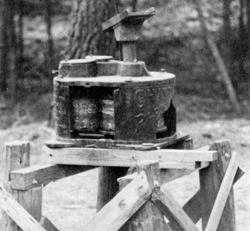
The majority of the population lived in the countryside from the beginning. The typical pine hills resident chose land bordering on a stream, built his log house on a ridge among the pines, and cleared land for a vegetable garden and fields to plant corn, and grain known locally as upland rice. Cotton was grown both for homespun purposes and for profit. Sometimes, if possible, sugar cane was planted to make syrup.
The diet of the piney woods people included a generous portion of sweet potatoes, prepared in a variety of ways, various types of vegetables with beans and peas predominating, and both wild and cultivated nuts and berries. Walnuts, peanuts, and chinquapins were consumed along with mayhaws, blackberries, wild strawberries, and grapes. The chinquapin looks similar to a chestnut, and has a flavor like a walnut. Peanuts were grown on most farms. Jean Crain, who lived in Mississippi a few miles past the border with Washington Parish, remembers harvesting peanuts. She recalls, "You would pull them up and usually take them into the shade and sit down and pick them off. We would have sometimes two barrels full. When company came, you parched peanuts." Boiled peanuts are still prepared and quite popular in this area.
Fruit trees were also planted and produced apples, peaches, persimmons, and cooking pears for the farm family's use. Each farm probably had a few chickens for fresh eggs and an occasional chicken in the pot. The wild, rangy cattle of the early days, which ran loose in the woods, were seldom milked. Instead they were rounded up once a year and driven to market, walking overland down country roads to towns where the cattle could be sold and shipped to New Orleans. A connecting link from the Holmesville Road to Covington led such cattle drovers to that market town after it came into existence. Even turkeys were driven to market along this road, roosting in trees by the side of the road with their owners sleeping on the ground beneath them.
In the late 19th century and early twentieth century, the timber was cut, and cattle could no longer range far and wide without straying into someone's cultivated fields. Accordingly, it became customary to keep cattle closer to home for dairying purposes. The building of railroads into the piney woods in the early twentieth century also offered a means of transportation to get milk to market, making commercial dairying a more feasible and popular livelihood.
The major source of meat for piney woods people, however, was the hog. No part of this August farm animal was discarded by the thrifty piney woods farmer. Even the hard portions of the hoof were ground up and used for medicinal purposes. Vivian Womack, a native of St. Helena Parish who lives outside Greensburg, describes how her father killed and dressed a hog.
In my childhood hogs were allowed to roam the woods free for whatever they could find. I recall my father riding out on his horse to bring a hog home to butcher. Often those hogs were wild, and if he couldn't catch it with a rope and bind it and bring it home, then he shot it with a gun, a rifle, and brought it home and butchered it. The hogs were generally killed in cold weather, and they were hung from a support, either a tree or a support built to hold them. They were slit from stem to stern, and the insides were taken out. Some of those insides were kept--the entrails or guts, as we called them, were kept to stuff sausage in. The lights and liver we used for hash along with the heart and feet, if we didn't use them for something else. The head was used to make hogshead cheese. The other parts of the hog were cut into different cuts of meat to be smoked in the smoke house over a hickory fire. Some of that sausage was used fresh as patties or stuffed into the cleaned entrails with a sausage grinder that had an attachment for stuffing. It, too, was hung in the smoke house over the fire with the other cuts of meat that were pork and were smoked over a period until dry and cured, and then at intervals, a smoke was built under it throughout even the summer time to keep away flies.
Every piney woods farm had a smoke house usually built of logs in which, during hog killing time, shanks of ham, sausages, and other cuts would be hickory-smoked. Inez Tate, a lifelong resident of St. Helena Parish, recalls that hog killing time was a time for sharing with one's neighbors. "When one family killed hogs, they took fresh pork to everybody in the community. They called it, "Take 'em a mess a meat."
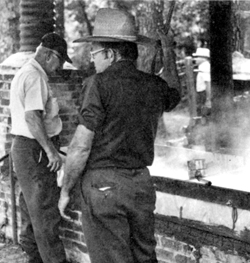
Memories of piney woods farm life spanning a period from the 1890s to the 1950s are recalled with vivid detail by a number of natives of this region. Zuma Magee, now deceased, was a ninety-two-year-old resident of Franklinton who still drove and took an active part in church work and civic activities at the time she was interviewed, and remembered well her early childhood in Washington Parish. She grew up on a 162-acre farm that her father had acquired from the Federal government's Homestead Act. She had seven sisters and three brothers. Mrs. Magee's father, John Adolphus Fendlason, first built a one-room log cabin to which he added rooms as the family expanded. He also built a dogtrot type of barn, a log crib for the corn, and an outside kitchen building, away from the main house. The chimney was made out of clay mud. She described her mother's cooking in these words, "Mother did most of her cooking on the fireplace. I can just see her. She had a skillet, and she had the broiler that she boiled things in. It was a round pot with three legs. She put her vegetables in it and cooked them, and at hog killing time, she had a bigger one that she would put hog feet in. Oh, it was so good, especially with the baked potatoes that had been put up there in the fireplace and baked with just the juice running out of them."
Mrs. Magee recalled that her father, in addition to his vegetable garden and fields of corn and cotton, also grew rice, which the family ate with melted butter. Coffee beans were purchased green in the sack and had to be roasted and ground into fresh coffee. Such purchases were made about once a year when he made a trip by wagon to Covington to get supplies. He always kept two bales of cotton to take to market to pay for what he bought. He'd buy one hundred pounds of salt, two barrels of flour, one hundred pounds of raw green coffee beans, bolts of material (bleached and unbleached domestic, voiles for Sunday dresses and calicos for ordinary wear), boxes of thread (the stores only had black and white), and cards of buttons. The children loved to accompany their father on these trips which lasted three days--one day to get to the outskirts of Covington, where they camped, one day to shop, and one day to return home.
Sewing and quilting were women's chores that occupied a lot of time for piney woods housewives. Mrs. Magee remembered that ladies sometimes accompanied their husbands to a neighbor's farm when their menfolks went to take part in a log rolling. The men would clear the land by cutting down heart pine timber, using log rolling sticks made out of hickory. Two men, one at each end of a log, would roll the log over to a pile, and with additional help, it would be piled up and burned. While they worked outside, the women would stitch on quilts hanging in their frames from the ceiling of the main room in the house. A get-together supper would climax their work day.
Mrs. Womack, remembering St. Helena Parish in the early twentieth century, recalls that mattresses and pillows were homemade--usually out of goose feathers from one's own flock, or out of corn shucks. She describes the wooden floors of the unpainted frame farm houses of her childhood as being bare, or covered with a rag rug, or one made out of corn shucks. The latter type was used to wipe feet on. She remembers:
The floors were scrubbed with water that had to be brought in from the well and the detergent we used was a strong washing powder called`Gold Dust'. Really its name was `Gold Dust Twins', but the familiar name was ‘Gold Dust.’ That was put in the water, and the floors were scrubbed with a scrub brush. The menfolks of the family made this scrub from a rectangular piece of board that had been bored with an auger. It had about eight holes in it and a hole in the middle for the handle. Then into those holes were drawn shucks. The floor was scrubbed with that scrub and washing powder, and then it was carefully rinsed with two or three clear waters. Then all that was swept up with a straw broom. The straw brooms were made in the fall from straw gathered in the field and bound into brooms. After the water had been swept off, they wiped up with a cloth, generally a fifty-pound flour sack. I recall as a child skating across the floors with that cloth to wipe up the excess water.
Zuma Magee recalled making liquid or soft lye soap out of ashes for cleaning the floors and washing clothes. Her family kept a barrel into which they placed wood ashes. Water was poured over these ashes to make lye. This acid solution was added to hog lard and cooked in an iron pot to make brown soft soap. It was stored in containers made out of gourds which the Fendlasons grew on their garden fence.
The cultivation of cotton, both for home use and as a money crop, was common throughout the Piney woods country. The acreage grown was small compared to the Delta area of Mississippi or north Louisiana, but it did provide a way to make extra income. Usually all of the family helped in the cotton fields--the various tasks included scraping cotton (which was removing weeds); putting poison on the bolls as they developed, to keep boll weevils from sucking the sections of the boll into distorted growths; and finally, picking the cotton at harvest time. Mrs. Magee's father at first grew brown cotton, but later he switched to the white cotton variety. She remembered her grandmother picked the seeds from the cotton by hand, carded it, and spun it into yarn, which she used to knit socks. She sold these in Amite, where she went to trade. Some neighbors and friends had looms as well as spinning wheels. They could weave homespun cotton cloth approximately 27 inches in width.
As the twentieth century progressed, cotton cultivation declined in the hill country, largely due to the depredations of the boll weevil. But in the 1940s, Mrs. Crain's mother still hired thirty or forty extra helpers from the area to supplement the family in scraping and picking cotton. After they picked their own cotton, her family might help her uncle who lived nearby. "After that, it was time to gather corn, we called it breaking the corn. You actually take the ear of corn and break it off the stalk, and you throw it in rows, and then you come along with baskets and pick it up and put it up on trucks and haul it in and sell it," she explains.
Doctors were few in the rural parts of southeast Louisiana in the early 1900s and only came in times of emergency, sometimes under adverse physical conditions. Eunice Catha and her sister, Nora Lambert, recount an incident which happened to their father, Dr. J. W. Lambert of Tangipahoa in Tangipahoa Parish. Dr. Lambert sometimes made trips on horseback late at night into the woods to visit seriously ill patients. His visits took him through territory where men from feuding families were laying in wait for each other with guns. He was told by one involved in the feud to carry a lantern and hang it on a certain side of his saddle to help identify himself. After doing this one night and encountering no trouble, he met this man the next day and was told by him, "You passed so close to me in the woods last night, I could have reached out and touched you."
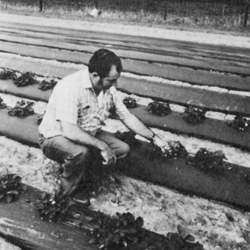
Mrs. Bond recalls that their family physician lived in Clinton, in East Feliciana, a long distance from their St. Helena home. Once he came to attend her mother at the birth of a baby, and had to swim the river on horseback to reach their farm. When he arrived, he was sopping wet and had to change into dry clothes, which belonged to Mrs. Bond's father, before delivering the baby.
Mrs. Womack points out that there was no prenatal care for expectant mothers and their offspring. The doctor from the nearest town usually had not seen the maternity patient before he was called to ride out and deliver her baby. He might not see her again until the next child arrived. A midwife would usually assist the doctor and would stay after the baby's birth. She did more than care for the mother and baby. She took over the housework while the mother rested in bed. "It was customary for a woman to stay in bed much longer than they do now," Mrs. Womack explains, "I suspect part of the reason was that that was the only time they got to rest. I recall my mother staying in bed as long as two weeks after a baby's birth." The Black midwife who assisted her mother is fondly remembered by Mrs. Womack as the one who instructed her in the facts of life, as a teller of old folktales, and as an able household helper.
Home remedies were heavily relied on for ailments such as headaches, colds, burns, and snakebites. Poultices made out of corn meal were used to soothe headaches. Kerosine and turpentine were both utilized to treat the sick. A few drops of turpentine were mixed with sugar in a teaspoon to relieve a sore throat and coughs. Kerosine was also rubbed on a swollen leg to relieve snakebite pain. Louise Ard, who was reared about four miles west of Greensburg, recalls that one remedy for treating a bad cut was to pour boiling water on peach leaves and bind them on the cut. To remove a splinter, she adds, they would place a piece of raw fat meat on the affected area to draw the splinter out. For severe illness, such as pneumonia, Thermon Dyson of Washington Parish remembers his grandmother and the other women in the area parching hog hooves on the wood stove. When the hooves were brown enough to crumble up, a tea was made out of them. It tasted as bitter as quinine but was considered good for a patient suffering from fever and congestion. A salve could be made of pine pitch and beeswax, and pine needles were boiled to make a tea to treat coughs. Sassafras tea was drunk in the fall and spring, and lime water in the spring, "to purify the blood." Sulphur and molasses was another spring tonic. To aid a baby over the teething ordeal, asafetida was placed in a small bag and hung around the baby's neck. This, also, was believed to be protection against communicable diseases. Children and adults, as well as babies, wore such bags. Burns were treated with flour and lard, or axle grease.
The working day was long and hard for Piney woods people, but time for amusements, such as the box suppers, was found occasionally. Other recreational activities included swimming in the creeks and rivers (which were generally higher in the early twentieth century than they are today), and hunting for such quarries as quail, ducks, wild turkeys, rabbits, squirrels, and deer. Beagles were, and still are, the favorite hunting dogs for rabbits and small animals. Bird dogs are owned by the more prosperous citizens.
Fox hunting is a popular pastime among some residents of southeast Louisiana and Mississippi on Saturday night. Hunting dogs are allowed to run loose sniffing out a fox, while the hunters gather around a fire in the woods and swap hunting yarns. They can tell which ones are in the lead by the barks of the dogs. The hunters only join in the hunt as it reaches its climax. The fox is often captured and released to be hunted another time.
Talking politics as a pastime has always held a special fascination for residents of St. Helena, Tangipahoa, and Washington parishes. The citizens of Washington Parish, in particular, follow local elections with as much relish as national or state contests. The police jury elections are just as important to them as the governor's race. A typical election night scene includes crowds gathered around the polls to find out the vote count. During the 1930s, Washington Parish, in general, voted strongly for Huey Long.
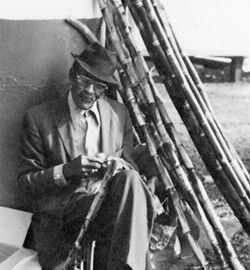
Weddings and funerals were occasions for the gathering of community families. Weddings usually took place in the home of the bride, with the ceremony performed by the local preacher or a judge. Mrs. Magee remembered her eldest sister's wedding. There was a festive family meal to celebrate. The young couple spent the first night of their married life at the bride's home, and the second night at the home of the groom. The second night was a time for good-natured teasing of the couple. Friends and relatives gathered at the groom's home, shouted, fired guns, and made all sorts of noise outside to attract the newlyweds' attention. Mrs. Tate, also, remembers that such a rousing welcome was given to her and Mr. Tate after their wedding.
This custom, which resembles the chivaree of French-speaking settlers in Louisiana, was called by Mrs. Magee "Ain Fair." Roughly translated, this would mean "our" from the Scottish "ain," and "good luck" or "good fortune" which is an obsolete meaning for "fair." Thus "our good fortune" would be the literal meaning of this roughhouse method of wishing good luck to the newlyweds.
One religious ceremony that has changed its setting from what it had been in the early twentieth century is baptism in the Baptist Church. Baptisms were held in rivers and streams. The congregation would attend and often sang hymns while the ceremony was performed. "Nearer My God to Thee" was the most popular for this occasion. Today, most baptisms are performed in a baptistry located inside a church. There are a few churches, however, which continue the old custom.
Revivals were community events of both religious and social significance in the first thirty years of the twentieth century. Mrs. Womack remembers:
In the summertime when the crops were laid by, there was held what was called protracted meetings which were actually revivals. In those days we had those fire-and-brimstone preachers. We had plenty of them. . . . At the end of the protracted meeting, which was generally two weeks, there was a dinner held on the grounds, and it was called "dinner on the grounds." I recall how we looked forward to these because the ladies always prepared fried chicken and chicken pies, salads, and cakes and pies and deserts of all kinds. Protracted meetings were also a setting for romance. The boys and girls generally began courting there.
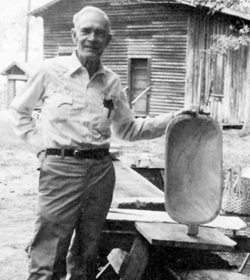
Mrs. Crain, whose experiences recall the 1940s, remembers attending "singing school" in the summer shortly before a revival was to be held in her area. A choral director, or preacher, would hold a brief one-week singing school, teaching the Shaped-Note gospel methods of singing. Picayune, Mississippi, was the center for the promotion and playing of such gospel music. Gospel quartets and choirs aspired to go there to perform from all over southeast Louisiana and Mississippi. In this method of teaching singing, the singers did not have to know how to read music and they were taught a different shape for each note in the scale--Do, Re, Me, Fa, Sol, La, Ti, Do. This tradition of singing schools had been followed in the piney woods of both Louisiana and Mississippi since the early twentieth century.
In the late 19th century, Sacred Harp gospel music, which used only three notes in the scale, was popular. Zuma Magee's mother played this music on a home pump organ, and neighbors would gather at their house every Saturday night for a gospel session. Frequently, as country fiddler Dewey Williams of Bogalusa recalls, country churches had no instrumental accompaniment for singers. They sang a cappella in duets, quartets, or with the entire congregation. "It was some of the most beautiful singing I've ever heard," he stated.
Up until the end of the 19th century, the only railroad running through the hill country in St. Helena, Tangipahoa, and Washington parishes was the Illinois Central Railroad. The notorious train robber, Eugene Bunch, was a native of Washington Parish and a school teacher before he took up a life of crime. He traveled from Mississippi and Louisiana over to west Texas robbing trains. Today there are local traditions all over Washington Parish about places where Bunch hid from the law and people who helped him. J. Leon Pounds, the old fiddler who gave Williams his first fiddle, was a friend of Bunch and sheltered him at his house. The last train that Bunch robbed before he was killed was the Illinois Central on its way to New Orleans through Tangipahoa. After boarding and robbing the passengers, he escaped by horseback and disappeared into Washington Parish. Without good roads and no rail lines into that parish for pursuers to use, he was able to escape easily. He was finally shot at Muster Ground Creek between Pine and Varnado in Washington Parish in 1892. The man who shot him was supposed to be a friend bringing him fresh clothes.
Within a few years of Bunch's death, isolation of Washington and St. Helena Parishes began to come to an end with the coming of large national lumber companies into southeast Louisiana. They built railroad lines to connect lumber mills, and new towns sprang up along the tracks. Bogalusa, called the "magic city," went from wilderness in 1906 to 1,500 inhabitants within a year. Some existing small towns even moved their locations to take advantage of the rail service. Daniel "Scrap" Fornea, the mayor of Varnado, explains that his town chose to do so in 1907. Such rail service not only carried timber to lumber mills, it also stimulated the growth of the dairy industry, and the commercial growth of garden vegetables for markets such as New Orleans. The deforested land created by widespread timber cutting opened up additional acreage for such cultivation or dairying. In the two decades before World War II, Varnado maintained a packing shed for the large volume of vegetables to be shipped to market by the railroad.
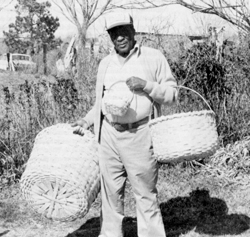
The coming of the railroads and the cutting of virgin timber began the break up of the piney woods' isolated, traditional way of life. Proper surfacing of roads and the advent of electricity for farm homes, which was largely dominant by the end of the forties, continued this trend. Today moderate-sized family farms continue to function in this area. The cultural heritage of the piney woods is kept vitally alive in the annual Washington Parish Free Fair, which is one of the heaviest attended county-level fairs in the United States. In addition to its prize vegetables, cattle, and carnival midway, this fair offers a glimpse of old-time folkways in its Mile Branch Settlement, a recreation of authentic log buildings in which citizens demonstrate crafts, cooking, and country music. In addition to the farmers who still make their living from the soil, a large number of residents, particularly in St. Helena, work outside their parish in metropolitan areas. They commute every day because they want to live in a rural setting. To them, and to most residents of the piney woods area, it still offers the good life: fresh water, ozone air, replanted pine forests, and the basic values of their ancestors in family life, politics, and religion.
Bibliography and Archival Resources
Ard, Louise. Montpelier, Louisiana. Interview by Joy J. Jackson. February 14, 1984.
Bond, Cornelia. Montpelier, Louisiana. Interview by Joy J. Jackson. February 14, 1984.
Carter, Prentiss B. "The History of Washington Parish, Louisiana, as compiled from the Records and Traditions." Louisiana Historical Quarterly 1 (1931): 36-59.
Carter, Texanna. "History of Washington Parish." Southeastern Louisiana University Archives and Special Collections. (Typewritten.)
Catha, Eunice Lambert and Lambert, Norma. U. W. and Julia Lee Lambert: Family Profile. (n.p., n.d.).
Crain, Dr. J. Larry. Hammond, Louisiana. Interview by Joy J. Jackson. April 11, 1984.
Crain, Jean. Hammond, Louisiana. Interview by Joy J. Jackson. April 11, 1984.
Crain, Nellie Ruth. Varnado, Louisiana. Interview by Joy J. Jackson. February 21, 1984.
Downey, James C. "Sacred Harp Singing in the Piney Woods." Speech presented at the First Session of the L. O. Crosby, Jr. Memorial Lectures in Mississippi Culture. "The Piney Woods: A Human Perspective," University of Southern Mississippi, March 30, 1984.
Dyson, Thermon. Franklinton, Louisiana. Interview by Emma Route, February 19, 1979.
Fornea, Daniel. Varnado, Louisiana. Interview by Marilyn Vessier, February 21, 1984.
Gibbs, Daunton. Franklinton, Louisiana. Interview by Marilyn Vessier, April 28, 1982.
Hickman, Nollie Wade. "History of Forest Industries in the Longleaf Pine Belt of East Louisiana and Mississippi, 1840-1915." Ph.D. dissertation, University of Texas, 1958.
Kniffen, Fred. Louisiana: Its Land and People. Baton Rouge: Louisiana State University Press, 1968.
Magee, Zuma. Franklinton, Louisiana. Interview by Vicki Knight. November 11, 1981; April 21, 1982; May 2, 1983; January 27, 1984.
Maxwell, Cordelia. "A Place-Name Study of Washington Parish." Louisiana Studies (Northwestern State University) 3 (1971): 170-186.
Napier, Col. J. J., III. "Piney Woods Past: A Pastoral Elegy." Speech presented at the First Session of the L. O. Crosby, Jr. Memorial Lectures in Mississippi Culture. "The Piney Woods: A Human Perspective," University of Southern Mississippi, March 30, 1984.
Nichols, C. Howard. Tangipahoa Crossings. Baton Rouge: Moran Publishing Corporation, 1979.
Pigott, Ruth. Varnado, Louisiana. Interview by Joy J. Jackson. February 21, 1984.
St. Helena Parish Bicentennial Commission. St. Helena Parish Colloquialisms. Greensburg: Florida Parishes Vocational School, 1974.
Tate, Inez. Montpelier, Louisiana. Interview by Joy J. Jackson. February 14, 1984.
Varnado, Michael. "Crossing Jordan." Slide collection on Cemeteries in Tangipahoa Parish. Center for Southeast Louisiana Studies, Southeastern Louisiana University.
Warner, Ozzie Mae. Franklinton, Louisiana. Interview by Marilyn Vessier, November 10, 1981.
Williams, E. Russ, Jr. "Migrant Trails to and through Louisiana." Speech presented at the History and Genealogical Symposium, Southeastern Louisiana University, February 26, 1983.
Williams, G. Dewey. Bogalusa, Louisiana. Interview by Joy J. Jackson. April 26, 1984.
Womack, Vivian. Greensburg, Louisiana. Interview by Joy J. Jackson. April 10, 1984.


